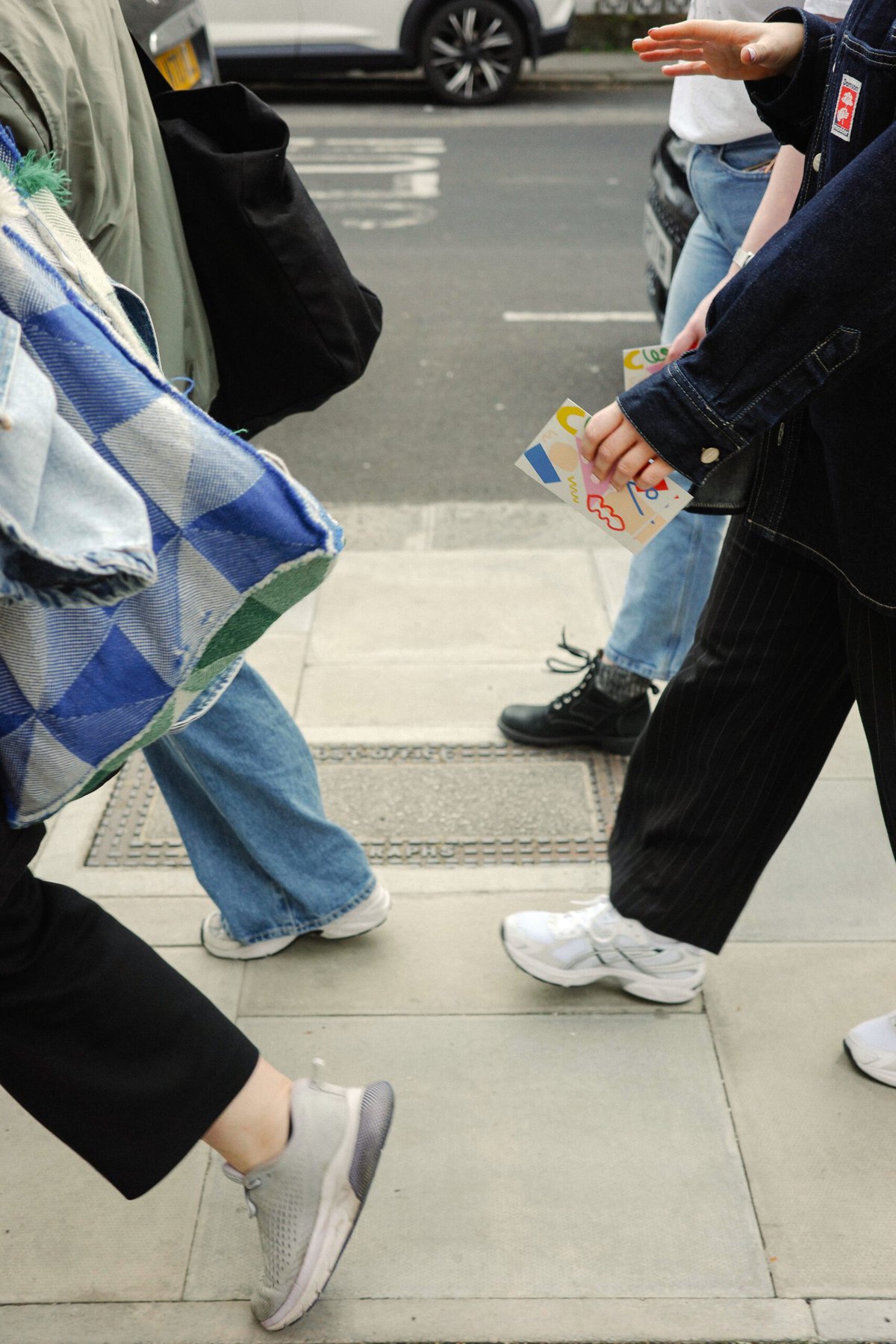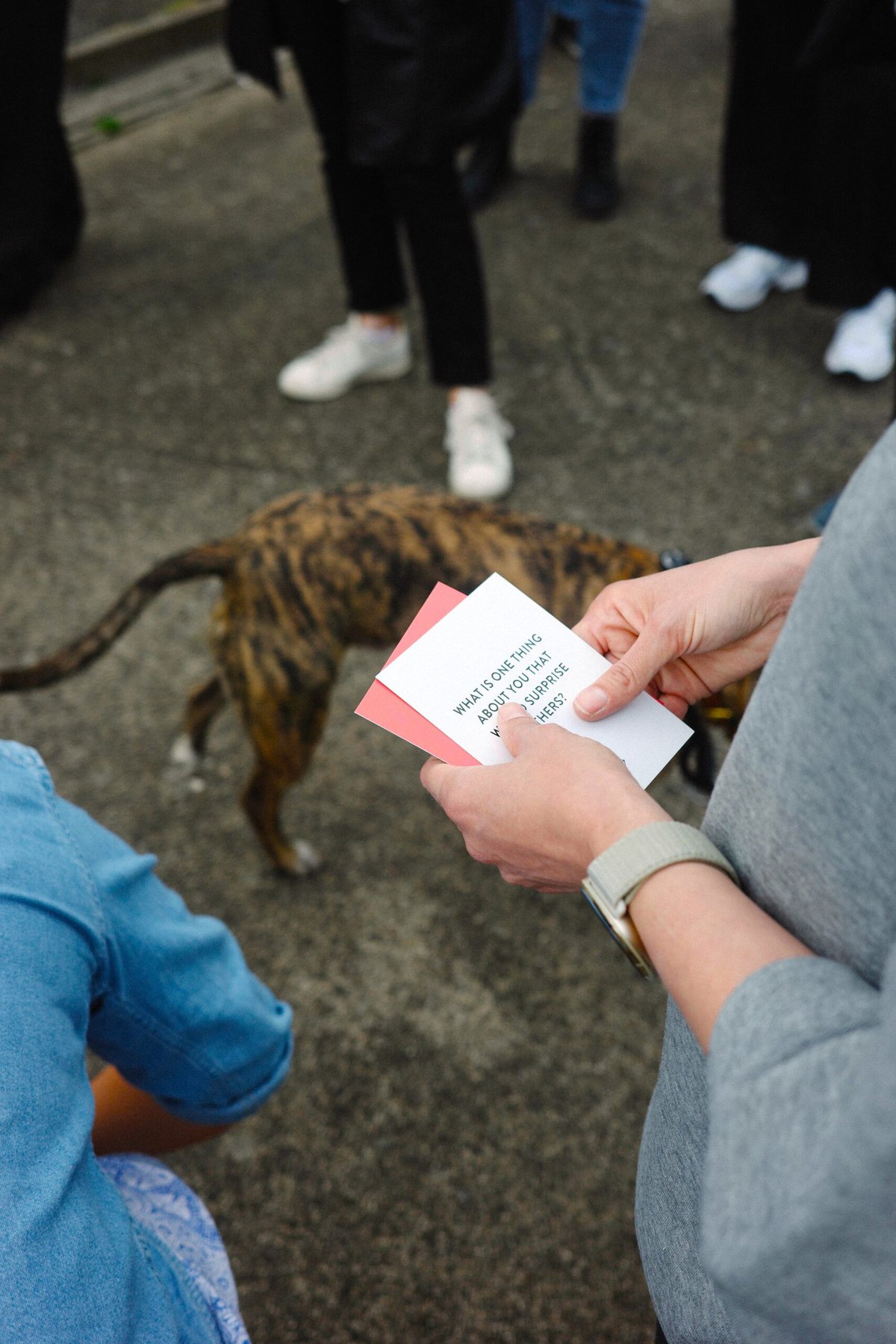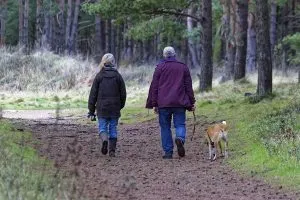

A Patient Is a Person is a series about how whole-person health is transforming the patient journey. It is supported by funding from UPIC Health.
The first rule of Walk Club, we’re instructed, is to leave something behind. Not a literal piece of baggage, but one of those metaphorical ones that many of us carry. Whether it’s something that happened earlier in the day or an ongoing feeling of discontentment, we’re asked to visualize physically leaving it on the ground before we begin our walk.
The second rule of Walk Club is to have open ears and an open mind, as we prepare to ask and answer questions from the topic cards we’ve all just selected, with people we have only just met.
The third rule of Walk Club is to bring an umbrella. It may be the middle of summer, but this is London, after all.

With that, the group I’ve just joined sets off on a 2.5-mile walk. We start at Coal Drops Yard in Kings Cross, a revitalized industrial precinct now packed with buzzy bars and restaurants and vibrant clothing stores, but the scene of many a warehouse rave party in the 1980s and 1990s.
The buzz has the potential to distract from the task at hand: to walk and talk for the next hour, feeding our bodies and minds by combining exercise and therapy. Crowds have flocked to a free outdoor cinema, sipping large, orange-colored cocktails from oversized glasses. Food trucks ply their wares, while children weave in and out of the grid that makes up the Granary Square fountains. As we descend to the path along Regent’s Canal, music booms out of docked boats, while people browse for their next good read from one that’s been converted into a waterside book store. All underneath rumbling gray clouds that are expanding and darkening by the second.
As we cut away from the canal path, we pause at Thornhill Bridge Community Garden for a group check-in, before continuing up into Barnard Park. Here, the vibe visibly shifts away from the trendy scene we’ve just passed through to Londoners going about their daily lives — dog walkers, runners, commuters and after-school sports clubs.
Guided by therapists Polly and Kate, our walk now becomes less casual and influenced by what the Kings Cross crowds are doing, but more intentional, and about us. In groups of two and three, we begin posing questions from the topic cards we chose earlier, pausing at intervals for Polly and Kate to check in with the group.
One of my trio asks me about how I feel when I see other people putting their feet up, as I’ve chosen the card marked, “For people who are always tired.” Easy: jealous, I answer, and I explain why. With two young children and work to balance, there’s little room in my life for the luxury of relaxing. Time away from the family seems like an unreasonable ask, because it means someone else has to create the space for me to do that. But remembering the baggage I left behind — feelings of negativity and resentment — reminds me to shed some positive light on the situation, too. This evening, I have indeed chosen myself for once. And it feels good.
It’s then my turn to ask one of my walking partners, whose chosen topic card is focused on the inability to switch off from work. We talk about how easily she brings her work mindset home, especially now that she’s just moved in with her partner. As a product designer, her role is to think of solutions and features that make a product easier to use. Applying that thinking to home makes sense to her, like introducing a cleaning schedule for the apartment. Yet her partner doesn’t think the same, causing conflict.
The third in our walking trio has identified herself as a worrier, through the card she has chosen. She’s asked to consider a specific situation that’s concerning her and how her head, heart and gut may all be reacting to it. This sparks a discussion about the differences between these three, and how they influence our actions. Together, we conclude that ultimately, how we feel often dictates what we do, despite what we rationally can see is the way forward — and this can be the hardest thing to change.
Finding our philosophical flow, we drift away from the scripted cards and into more of a free-flowing conversation, as we wind deeper into residential neighborhoods lined with identical, white-terraced houses. One street even has matching black metal sphinxes guarding each front stoop, a throwback to the properties’ Victorian heritage, a time when upper class Brits became enamored with Ancient Egyptian culture. This provides the backdrop for an exploration of why we do the things we do, even if we know they’re not the best thing for us or others.
Weighed down by negative news?
Our smart, bright, weekly newsletter is the uplift you’ve been looking for.At the end of the Sphinx street (Richmond Avenue, actually) is Thornhill Square, once under lock and key for the wealthy residents’ exclusive use, but now open to the public. Over the road is Barnsbury Wood, a nature reserve in the middle of London — both urban green spaces I never knew about, despite having previously lived in the capital for over 10 years. At Thornhill Square, Polly and Kate lead us in an exercise in being present, observing the colors, smells and textures, from the fat orange roses blooming, to the pineapple weed — which actually smells like pineapple — inconspicuously thriving among the grass, to the rough bark of the trees.
Not only is there a sense of delight in landing amidst these unexpected oases, but there’s an undeniable freedom in following a leader, so we can focus on and enjoy the simple acts of walking and talking — the fourth rule of Walk Club.
Walk Club was launched in spring 2024 by the founders of Self Space, a therapy company whose branches aren’t tucked away in high rise offices, but are found on some of London’s most popular shopping and dining streets. They’re decked out to look like retail stores, too, supporting the company’s premise that therapy, and talking about mental health, should be out in the open. Tickets for a walk were originally £10 (around $13), redeemable against a minimum £60 (around $77.50) therapy session, but Self Space has since made them free to make them available to anybody, without cost being a barrier.

It’s clear that openness, such a key part of Walk Club’s ethos, is deeply valued by co-founder Chance Marshall, who posts regularly on LinkedIn about his difficult childhood and having weekly therapy to this day. “Our work is as much a campaign against loneliness as it is about getting more people into therapy,” Marshall has written on the platform.
“Loneliness tricks us into thinking we are the only one who feels it. But every human on the planet has experienced moments of loneliness and aloneness,” Marshall notes — and while those feelings can pass quickly, they don’t always: “Sometimes, taking that first step out of stuck-ness and into movement is the hardest part. So [through Walk Club] we’re inviting people to take that first step, together.”
As fellow co-founder, Jodie Cariss, adds in an email to me: “Walk Club has been a way for us to support people outside of the therapy room, getting us outdoors, off our phones and connecting with new people. Much of therapy is creating meaningful moments of conversation — Walk Club has helped us open this up even further.”
Walk Club is certainly lifting a load off participants’ shoulders.
“I learned I could have a real conversation with someone I had never met, enjoy it, engage whole-heartedly, listen with empathy with no need to ‘fix.’ And knowing as I gave my companion a hug at the end that I would probably never meet her again and that that was okay,” one Walk Club member wrote.
“It’s good to talk and reflect and realize everyone faces their own challenges in life and sometimes the stories are similar in terms of outcome,” wrote another.
While 200 people have participated in Walk Club events so far, Self Space isn’t alone in its endeavors to connect people in a country where nearly half of adults report some kind of loneliness, according to the Campaign to End Loneliness. Seven percent even say they experience it chronically — and those in London are more likely to be affected than people in the rest of the UK.
The Walk and Talk Movement runs community walks across South West London every Saturday, and has hosted over 500 of these, and 10,000 participants, since it began in 2021. Bipolar Lab, a clinic for those with bipolar disorders, has also run walking therapy sessions with its patients. Founder Dr. Yanni Malliaris has linked the practice back to the Ancient Greek philosophers, who believed it promoted a more equal relationship between therapist and patient — or in their case, student and teacher.
The benefits of walking therapy have been documented by researchers, too. A trial of 20 female patients with post-traumatic stress disorder (PTSD) in Canada found that incorporating walking into their therapy sessions reduced their stress levels and PTSD symptoms. Walk and talk coaching in a group of 40 men and women in the Netherlands with stress and burnout helped ease those, and improved concentration, self-esteem and mindfulness. And a study of 32 UK therapists offering walk and talk therapy sessions found it helped clients open up more and strengthened the connection between body and mind.
Recognizing the value of intentional walking, versus merely taking a casual stroll, the online coworking platform Flown has embedded around 60 10-minute meditative walks into its offering. It’s a way of preparing the brain for — or relieving it from — the “deep work” the platform champions through its live, guided work sessions, in which members log into to find focus for in-depth tasks, often related to writing. The walks, as separate audio files, take themes like “Bravery,” “Cherished Memory,” “Movement” and “Gratitude,” for users to plug into as they take their desired route.
“For a lot of people, meditation is a very difficult thing to do, to sit still and just be aware of your breath, and be aware of the fact that, while emotions and thoughts happen to you, you are not your thoughts, and your feelings. But that can be very hard for people to acknowledge,” says Alicia Navarro, Flown’s founder and CEO.
“An intentional walk, for many people, is a much more achievable form of meditation because there’s a purpose to it. You’re not just experiencing the physicality of a walk, but the sensory experience of it. What do you notice here that you have not noticed before? How does the wind feel on your skin? How do the leaves look on the trees? What kind of noise are they making? And because you’re not sitting still — you’re in the world — it may feel more attainable as a form of meditation.”
Navarro’s point about achievability resonates. Hiring a babysitter to watch my kids for the day while I lounge at a spa is currently my idea of heaven, but not realistic. Spending the evening taking a purposeful walk, while perhaps not as decadent, ticked a lot of boxes for me. I got a break from my boisterous boys — and literally took some time to smell the roses. I gained empathy and perspective from my fellow Walk Club members. And when the gray skies turned to rain just minutes after bidding everyone goodbye, I couldn’t help but laugh.






